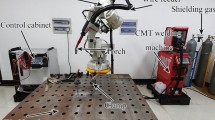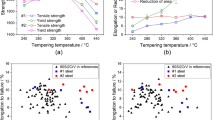The authors have studied grade R260 rail steel after austenization in the temperature range from 800 to 930°C and isothermal soaking at 500, 550, and 600°C followed by quenching in water. The steel structure and abrasive wear resistance were characterized. Recommendations concerning an increase in steel wear resistance were provided.




Similar content being viewed by others
References
Railway Applications. Track. Rail. Vignole Railway Rails 46 kg/m and Above, 13674–1. BS EN (2011).
K. Cvetkovski, Influence of Thermal Loading on Mechanical Properties of Railway Wheel Steels, PhD Thesis, Chalmers University of Technology, Gothenburg, Sweden (2012).
S. S. Sahay, G. Mohapatra, and G. E. Totten, “Overview of pearlitic rail steel: Accelerated cooling, quenching, microstructure, and mechanical properties,” J. ASTM Int., 6(7), 1 – 26 (2009).
H. K. D. H. Bhadeshia, “Some phase transformations in steels,” Mater. Sci. Tech. Ser., 15, 22 – 29 (1999).
Steels: Processing, Structure, and Performance: C15, ASM International (2005).
H. Yokoyama, S. Mitao, and M. Takemasa, Development of High Strength Pearlitic Steel Rail with Excellent Wear and Damage Resistance, Report NKK/No. 86, JFE Steel Corporation, Japan (2002).
J. Herian and K. Aniolek, “The structure and properties of steel with different pearlite morphology and its resistance to abrasive wear,” AMSE, 31(2), 83 – 86 (2008).
J. Herian and K. Aniolek, “Abrasive wear of railway sections of steel with a different pearlite morphology in railroad switches,” J. Ach. Mat. Man. Eng., 43(1), 236 – 243 (2010).
F. G. Caballero, C. Capdevila, and C. G. Andre’s, “Modeling of the interlamellar spacing of isothermally formed pearlite in a eutectoid steel,” Scr. Mater., 42, 537 – 542 (2000).
F. C. R. Hernandez, G. D. Nicholas, A. Polycarpou, and K. Gonzales, “Correlation between laboratory ball-on-disk and fullscale rail performance tests,” Wear, 270, 479 – 491 (2011).
O. P. Modi, D. P. Mondal, B. K. Prasad, et al., “Abrasive wear behavior of a high carbon steel: effects of microstructure and experimental parameters and correlation with mechanical properties,” Mater. Sci. Eng. A-Struct., 343, 235 – 242 (2003).
J. Herian and K. Aniolek, “Abrasive wear of railway sections of steel with a different pearlite morphology in railroad switches,” JAMME, 1, 236 – 243 (2010).
K. M. Lee and A. A. Polycarpou, “Wear of conventional pearlitic and improved bainitic rail steels,” Wear, 259, 391 – 399 (2005).
A. M. Elwazri, P. Wanjara, and S. Yue, “Measurement of pearlite interlamellar spacing in hypereutectoid steels,” Mater. Charact., 54, 473 – 478 (2005).
F. A. M. Alwadhi, A. Kapoor, and F. J. Franklin, “Subsurface microstructural analysis and mechanical properties of pearlitic rail steels in service,” Wear, 302, 1–2, 1453 – 1460 (2013).
C. Dayot, A. Saulot, C. Godeau, and Y. Berthier, “Tribological behavior of pearlitic and bainitic steel grades under various sliding conditions,” Tribol. Int., 46, 128 – 136 (2012).
K. Aniolek, J. Herian, M. Ciesla, and G. Skotnicki, “Shaping the structure during rolling and isothermal annealing, and its influence on the mechanical characteristics of high-carbon steel,” Mater. Sci. Eng. A-Struct., 608, 149 – 154 (2014).
H. Rastegari, A. Kermanpur, and A. Najafizadeh, “Investigating the effects of short time austenitizing and cooling rate on pearlitic microstructure and mechanical properties of a hot rolled plain eutectoid carbon steel,” Mater. Design., 67, 217 – 223 (2015).
M. Ciesla, J. Herian, and G. Junak, “Influence of pearlite morphology on cracking characteristic curves of R260 steel,” Key Eng. Mat., 598, 39 – 44 (2014).
J. Herian, K. Aniolek, M. Ciesla, and G. Skotnicki, “Shaping the structure during rolling and isothermal annealing, and its influence on the mechanical characteristics of high-carbon steel,” Mater. Sci. Eng. A-Struct., 608, 149 – 154 (2014).
J. W. Ringsberg and T. Lindback, “Rolling contact fatigue analysis of rails including numerical simulations of the rail manufacturing process and repeated wheel rail contact loads,” Int. J. Fatigue, 25, 547 – 558 (2003).
S. L. Srimani, A. C. Pankaj, and J. Basu, “Analysis of end straightness of rail during manufacturing,” Int. J. Mech. Sci., 47, 1874 – 1884 (2005).
O. Kalaycioglu, Kardemir’de Ray Üretiminde Iyile°tirmeler, PhD Thesis, University of Sakarya, Sakarya, Turkey (2006).
J. Spannar, A New Approach of Assessing Rail Roughness, Report Banverket, Operations Division, Infrastructure, Track & Civil Engineering, Borlange, Sweden.
A. Roviraa, A. Roda, M. B. Marshall, et al., “Experimental and numerical modelling of wheel-rail contact and wear,” Wear, 271, 911 – 924 (2011).
F. A. M. Alwahdi, A. Kapoor, and F. J. Franklin, “Preliminary investigation of the effect of roughness in Dynarat simulation,” Wear, 267, 1381 – 1385 (2009).
A. Kapoor, F. J. Franklin, S. K. Wong, and M. Ishida, “Surface roughness and plastic flow in rail wheel contact,” Wear, 253, 257 – 264 (2002).
J. F. Cordier and P. Fodiman, “Experimental characterization of wheel and rail surface roughness,” J. Sound Vib., 3, 667 – 672 (2000).
F. J. Franklin, J. E. Garnham, D. I. Fletcher, et al., “Modelling rail steel microstructure and its effect on crack initiation,” Wear, 265, 1332 – 1341 (2008).
H. Chen and M. Ishida, Influence of Rail Surface Roughness Formed by Rail Grinding on Rolling Contact Fatigue, Report QR/47/4/216-221, Railway Technical Research Institute, Japan (2006).
Y. Yildiz and H. Baycik, Abrasive Wear Effect of Surface Roughness in the Pearlitic Rail Steels, PhD Thesis, Bulent Ecevit University, Zonguldak, Turkey (2013).
Railway Applications. Track. Acceptance of Works, 13231-3, BS EN (2012).
F. C. R. Hernandez, G. D. Nicholas, D. D. Davis, et al., “Mechanical properties and wear performance of premium rail steels,” Wear, 263, 766 – 772 (2007).
F. C. R. Hernandez, G. D. Nicholas, A. Polycarpou, and K. Gonzales, “Correlation between laboratory ball-on-disk and fullscale rail performance tests,” Wear, 270, 479 – 491 (2011).
W. Lojkowski, M. Djahanbakhsh, G. Bürkle, et al., “Nanostructure formation on the surface of railway tracks,” Mater. Sci. Eng. A-Struct., 303, 197 – 208 (2001).
This study was sponsored by Project No. 2012-17-10-02 of the Bulent Ecevit University.
Author information
Authors and Affiliations
Corresponding author
Additional information
Translated from Metallovedenie i Termicheskaya Obrabotka Metallov, No. 5, pp. 46 – 49, May, 2020.
Rights and permissions
About this article
Cite this article
Kalaman, S., Baycık, H. & Aycan, O. The Effect of Austenization and Isothermal Soaking Temperatures on the Wear of Perlite Steel. Met Sci Heat Treat 62, 341–344 (2020). https://doi.org/10.1007/s11041-020-00564-7
Published:
Issue Date:
DOI: https://doi.org/10.1007/s11041-020-00564-7




